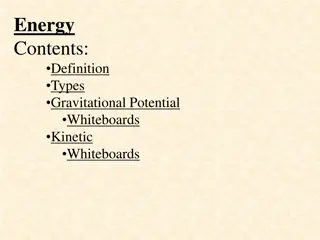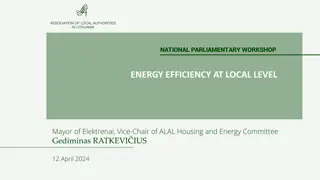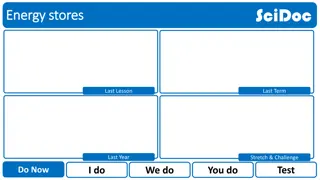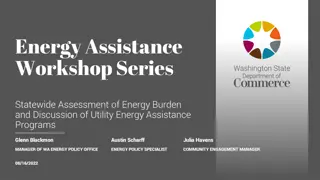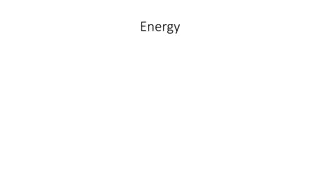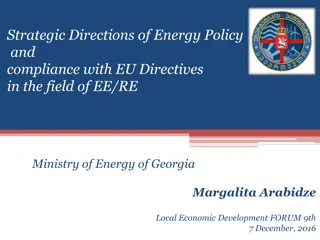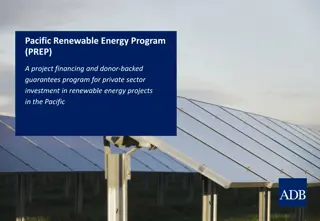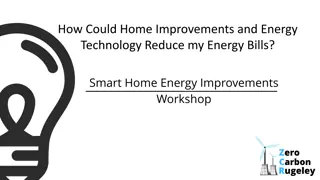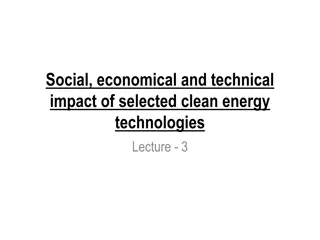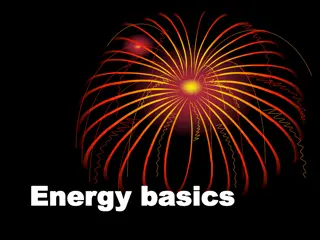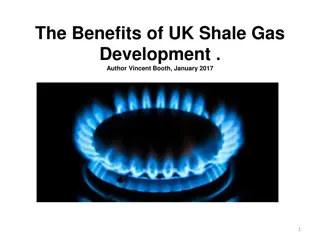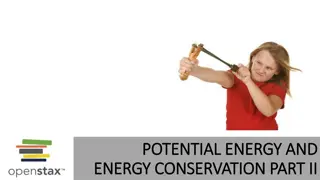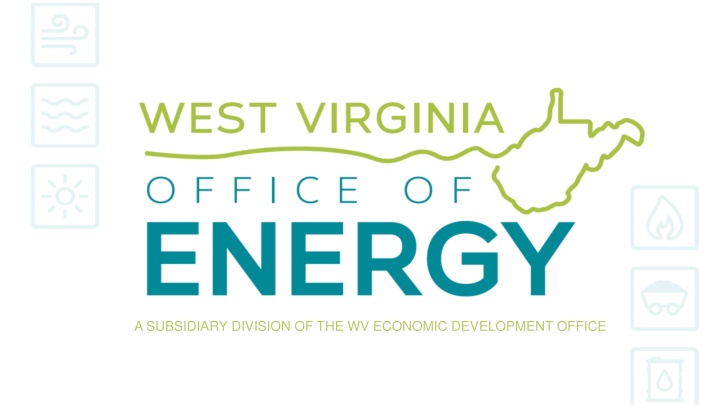
WV Economic Development Office Energy Program Details
This program by the WV Economic Development Office focuses on enhancing energy efficiency and renewable energy in K-12 schools, aiming to reduce greenhouse gas emissions, save costs, and improve student and teacher health. The initiative offers grants for various energy improvements, including solar installations and energy-efficient systems.
Download Presentation

Please find below an Image/Link to download the presentation.
The content on the website is provided AS IS for your information and personal use only. It may not be sold, licensed, or shared on other websites without obtaining consent from the author. If you encounter any issues during the download, it is possible that the publisher has removed the file from their server.
You are allowed to download the files provided on this website for personal or commercial use, subject to the condition that they are used lawfully. All files are the property of their respective owners.
The content on the website is provided AS IS for your information and personal use only. It may not be sold, licensed, or shared on other websites without obtaining consent from the author.
E N D
Presentation Transcript
A SUBSIDIARY DIVISION OF THE WV ECONOMIC DEVELOPMENT OFFICE www.energywv.org
Garrett Weaver Garrett Weaver Energy Program Manager
Agenda Introduction to 2024 Renew America s Schools Prize Details on the Prize application WVOE application process
Introduction to the 2024 Renew America s Schools Prize
Prize Purpose This program seeks applications that not only address the need for energy efficiency and renewable energy upgrades, but also create innovative and sustaining partnerships, leverage funding and economies of scale, and provide replicable and scalable models for sector-wide change. Energy consumption at U.S. public K-12 schools is a significant source of U.S. greenhouse gas emissions and the second highest operational expense to schools, second only to salaries. Packages of energy improvements can save even more energy than individual upgrades, and zero-energy or zero-energy ready construction can reduce energy consumption by more than 65%. These improvements can pay dividends for years to come: Every dollar saved on utility bills is a dollar better spent on educating children. Repairs, renovations, or installations to the facility envelope, air conditioning system, ventilation system, heating system, domestic hot water heating system, compressed air system, distribution system, lighting system, power system, and/or controls of a building. Renewable energy improvements such as rooftop solar, micro wind turbines, alternative fuel vehicle infrastructure, and purchase or lease of alternative fuel vehicles. Any Improvement that achieves energy savings and leads to an improvement in teacher and student health, including indoor air quality.
Prize Details PHASE 1 PHASE 2 PHASE 3 Strategic Plan + Energy Audits (Cooperative Agreement) Implementation (Cooperative Agreement) Portfolio + Team (Prize) PHASE 1 $300K $300K $300K PHASE 2 $500K $750K $1M PHASE 3 $7M $10.5M $14M 10 14 Schools & School Facilities 15 19 Schools & School Facilities 20+ Schools & School Facilities
PHASE 1: Portfolio + Team Up to 23 Winners at $300,000 cash prize each In Phase 1 ( Portfolio + Team ), competitors will identify a minimum of 10 schools/school facilities to be included in their application. The portfolio may span multiple LEAs. The portfolio should exhibit a high need for energy assessments and, ultimately, energy improvements. The goal of Phase 1: is for competitors to successfully assemble their project team, assemble their portfolio of school facilities, demonstrate the need for energy improvements at schools and school facilities in the defined portfolio, and outline their process to complete the tasks in Phase 2. Based on successful completion of Phase 1, winners will be invited to enter into negotiations with DOE for a Cooperative Agreement. Negotiations for Cooperative Agreement will require additional steps as outlined in the next few slides.
PHASE 2: Strategic Plan+ Energy Audits $500,000 to $1,000,000 per recipient ONLY winners from the Phase 1 Prize will be eligible to negotiate with DOE to receive a Cooperative Agreement for Phase 2 and Phase 3 funding. Phase 2 ( Strategic Plan + Energy Audits ) will be synonymous with Budget Period 1 of the Cooperative Agreement. Funding in Phase 2 will reimburse Grantees for costs associated with energy audits and strategic planning and design. DOE will allocate a set amount of funding per grantee, determined by the number of schools or school facilities submitted in their Phase 1 application. Goal of Phase 2: Recipients conduct The American Society of Heating, Refrigerating and Air-Conditioning Engineers (ASHRAE) Level 2 energy audits of all the schools/school facilities in the portfolio and develop a comprehensive Strategic Plan for implementing energy improvements. Energy audits and the Strategic Plan should provide schools with clear pathways to prioritize energy improvements, access private sector funding and/or tax credits, and realize high-impact health and safety benefits.
PHASE 3: Implementation $7,000,000 to $14,000,000 per recipient Phase 3 ( Implementation ) will be synonymous with Budget Period 2 of the Cooperative Agreement. In Phase 3, DOE will allocate a set amount of funding per grantee, determined by the number of schools/school facilities submitted in their Phase 1 application. Goal of Phase 3: Recipients oversee implementation of the energy improvements identified at the end of Phase 2. DOE will work with Recipients to ensure high-priority energy improvements are implemented within the allotted budget for Phase 3. Phase 3 should directly advance the measurable goals of energy savings and high impact health and safety benefits outlined in Phase 1.
Prize Application Components & Deadlines 1. Preparation, activation, and submission JUNE 13th, 2024, 5p.m. ET 3. Announcement AUGUST 2024 (anticipated) 2. Assessment Competitors complete their submission packages, following the instructions in the Rules document and submit online before Phase 1 of the contest closes. The Prize Administrator screens all completed submissions and assigns a panel of DOE-approved subject matter expert reviewers to independently score the content of each submission. DOE s SCEP considers input from expert reviewers and makes the final decision on all winners. Approximately 60 days after Phase 1 closes, the Prize Administrator notifies winners and requests the necessary information (IRS W-9 form, ACH form, and prize acceptance form) to distribute cash prizes. The Prize Administrator will then publicly announce the winners. Submission items: 1. Technical narrative 2. Energy Justice Mapping Tool Reports 3. School Energy Assessment (SEA) Form Tool Reports 4. Community Benefits Plan (CBP) 5. Resumes 6. Letter of Commitment 7. Summary Slide
Technical Narrative Need for planning & energy assessment Facility & community need Free and reduced-price lunch percentage per school/school facility Team composition, capability, and experience A description of the capacity of the eligible entity to provide services and comprehensive support to make energy improvements Implementation plan for Phase 2 A draft work plan of the intended achievements of the eligible entity at the school A description of the energy improvements the eligible entity would carry out at the school if the application were approved An assessment of the expected needs of the eligible entity for operation and maintenance training funds, and a plan for use of those funds, if applicable Impact and replicability Strategic partnership and scalability
Energy Justice Mapping Tool Reports DOE developed the Energy Justice Mapping Tool for Schools (https://energyjustice-schools.egs.anl.gov) to help applicants derive relevant needs information on a school-by-school basis. Competitors must use this tool to generate a report for each school facility within the submission. Need to upload a single .pdf document that includes the one-page summary report per school/school facility. This template can be found on HeroX under the Resources tab.
School Energy Assessment (SEA Form) Tool Reports Competitors must use DOE s School Energy Assessment (SEA) Form to generate a facility condition report, which is a needs assessment of the current condition of the school and school facilities that would receive the energy improvements. The SEA Form is available for download on HeroX under the Resources tab. Additional trainings on how to use the form can be found on: School needs and benefits assessment resources | DOE
Resumes & Letter of Commitment Resumes: Competitors must submit a one-page resume for each project manager and key personnel that includes contact information, education, certification, professional experience, and education. Letter of Commitment: Letters from portfolio schools/LEAs and any other key project partners identified at time of application should be submitted. These letters should state the entity s intent to participate in the proposed project and their role(s) should the project move forward. Each letter must not exceed one (1) page.
WVOE Portfolio Preparing for Phase 1 Applications can be completed here: Link Applications must be submitted by May 20th, 2024, 5PM ET Items you need for filling out the application: School or school facility point of contact Percentage of free & reduced-price lunch Identify if school falls under Low-Income/Disadvantaged community according to CJEST Identify the energy intensity if any energy audit at your school was performed previously Identify any planned or on-going energy improvement projects Prepare a Letter of Commitment by June 13th, 2024, 5PM ET




